A cook's guide to the Aegean - Europe
From the clay-pot chickpea stews of Paros to the fennel and cheese pies of Syros, former cookery school owner Rosemary Barron takes us on a culinary tour of five Greek islands
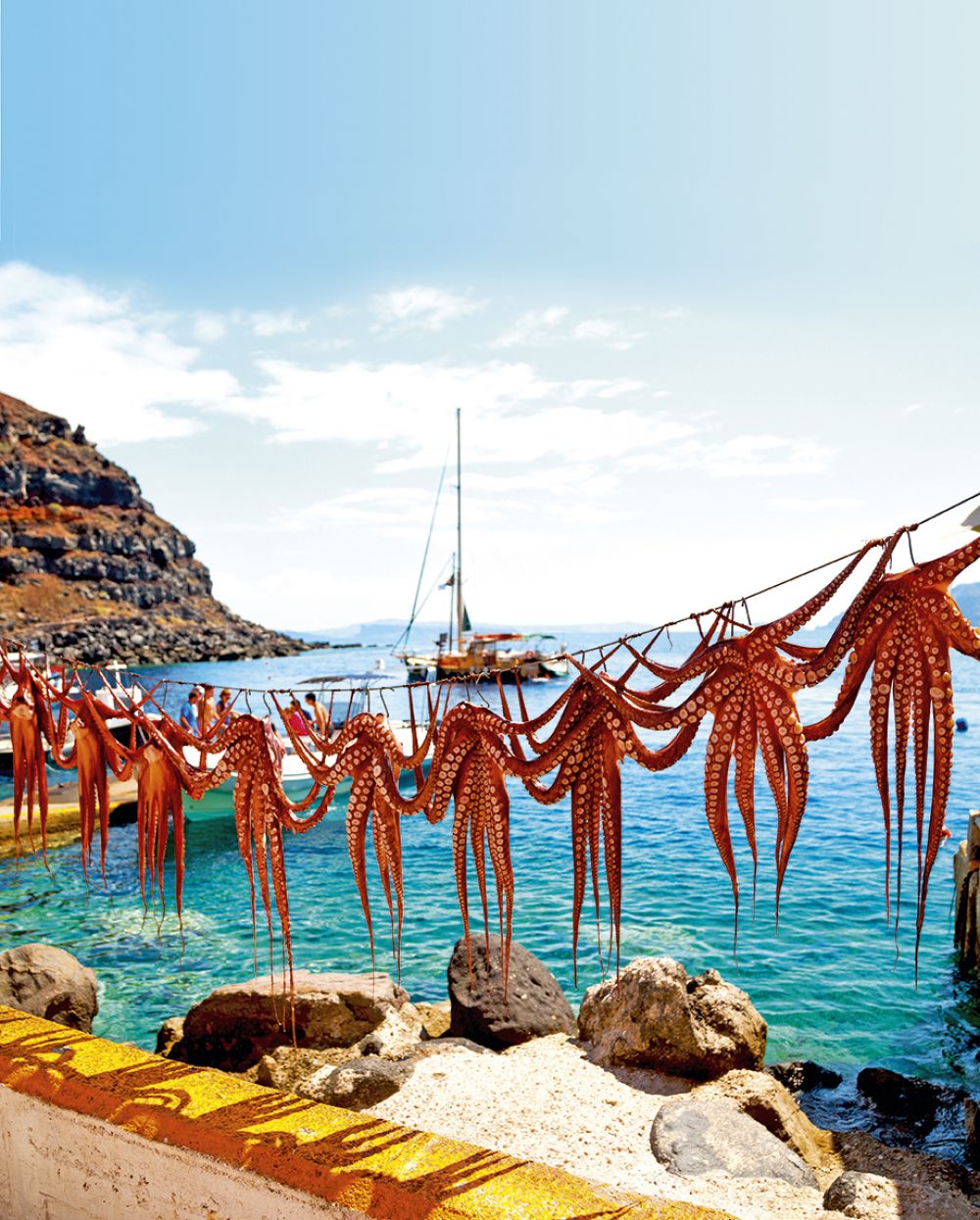
From the clay-pot chickpea stews of Paros to the fennel and cheese pies of Syros, former cookery school owner Rosemary Barron takes us on a culinary tour of five Greek islands
While this island is small, its natural larder is generous and its cooks are endlessly inventive. Visit and you'll find much to savour, from outstanding local cheeses to fennel-flavoured sausages
Syros is rightfully proud of its rich gastronomic legacy. This diminutive, 84sq km island is the beating heart of the 56-island Cyclades (24 of which are inhabited), but in the 18th and 19th centuries it was a cosmopolitan Eastern Mediterranean mega-port and home to the first cookbook written in Greek in modern Greece (1828).
Two steep peaks overlook the enchanting capital, Ermoupoli ('City of Hermes', the Greek god of trade), with a church, one Catholic, one Orthodox, standing atop each. Elegant, neoclassical mansions, small, whitewashed Cycladic houses, palm-shaded, terraced cafés and smart marble-paved squares surround a handsome harbour. To taste the culinary past, leave the grand Plateia Miaouli (main square) and walk towards Ano Syros to Lilis, one of the island's oldest restaurants. Owner Leonardo Roussos makes Syros speciality cured pork, louza, each winter, to take advantage of the cold winds. He soaks the meat
in brine for a day, rinses it, adds cinnamon, fennel seeds and other spices he prefers not to name, and squeezes the meat into a cleaned pig's intestine before leaving it to air-dry for at least a month. Savour slices of this pungent, salty delicacy with other mezes such as fennel and cheese pies, marathopites, and salads of mashed dried beans or potatoes.
Coffee and ouzo are both also part of food life here, so move on to one of the many coffee shops, kafenia, or ouzeries in nearby Vrondadho, the Orthodox quarter, and a maze of narrow passages, tiny squares, steep steps and arches. These were home to rembetiko – the blues-like music of the Greeks displaced from Asia Minor a century ago that was fuelled by ouzo and strong, aromatic coffees, kafes.
East of Plateia Miaouli, towards the sea, you'll find market stalls on Chios Street selling seasonal, locally grown vegetables – courgettes, complete with their bright-orange flowers, aubergines, melons, peppers, cucumbers – fresh fish, shellfish and cephalopods (octopus, squid, cuttlefish), the fishmonger filleting and de-scaling as you watch – and preserved meats – louza, blood sausages of onion, blackcurrants, mint and spices, haematies, and pork sausages strongly flavoured with fennel, marathies. In nearby delicatessen Prekas there's a marvellous array of dried herbs, capers that have been picked in the wild, sun-dried tomatoes and local cheeses – hard, cylinder-shaped San Michali and soft, spicy, peppery Kopanisti, made by pressing sheep's or goat's milk curds into cloth sacks to drain. Also on display are Syros sweetmeats, including sesame seed and honey wafers, pasteli, pressed dried figs with sesame seeds, almonds, cinnamon and bay leaves, pastelaria, baklava, vanilla almond paste between wafers, halvadopita, preserves of lemon blossom, tiny figs and pistachio nuts, glyka, and 'Turkish delight', loukoumia, a favourite of Asia Minor Greeks and made especially well on this island.
Island buses take you to villages and beaches past pine-covered hills, clusters of neat white houses and a peaceful landscape of herb-grazing sheep and goats, small, domed churches and inhabited monasteries. Visit Kini, 10km north of Ermoupoli, to enjoy a day's swimming or a boat trip to remote northern and eastern beaches, followed by a visit to a fish taverna, psarotaverna. In Finikas, to the south-west, Barbalias relies on its two fishing boats for the catch of the day; in Foradenes try fresh sheep's cheese pies drizzled with honey, myzithra, meatballs, keftedes, and the omelette-like fourtalia, flavoured with louza and cheese.
While the author of the first modern Greek
cookbook is unknown, Greek Cookery, the first written
in the native language, was published just over a
century later, in 1950, and is still in print today. Author
and chef Nikolaos Tselementes (1878-1958), himself
born and raised in the Cyclades, is an icon for the
many good home cooks and professional chefs here,
and has guaranteed that this graceful island stays
firmly on the Greek culinary map.
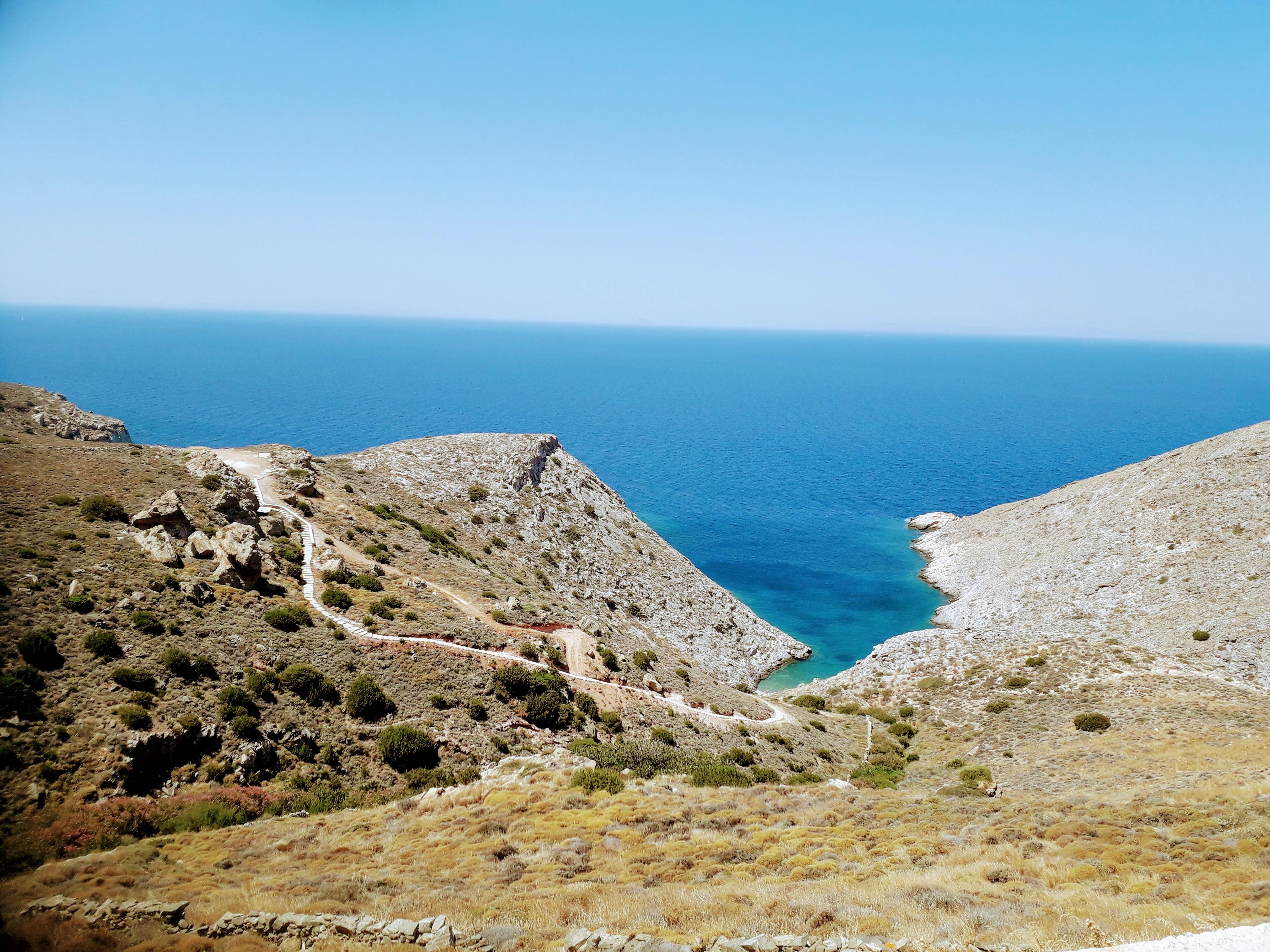
Photo by Maria Kourtesi/Unsplash
Drink in those magical views – and the excellent island wines – while grazing on mezes starring sweet tomatoes, white aubergine and fresh-off-the-boat fish
Drama is never far from Santorini. Enter the Exo Gonia, try chef Kostas Chryssocherakis's roast
caldera (the sea-filled volcanic basin) on lamb shanks with white aubergines, kotsi arnisio
a ferry from Athens for your first, stunning, sto fourno, fava with capers and onion, fresh goat's
sight of the island's small cave houses and dazzling
blue-domed churches perched on grey lava cliffs.
Thira, the island's ancient – and official – name, has
inspired artists since the sculptors of the beautiful
carvings of the Cycladic civilisation; equally, its soil,
and the island's careful farmers, have given cooks
and viticulturists unique and very special flavours.
Celebrated local winemaker Yiannis Tselepos says of the terroir, 'I follow the grapes. My philosophy is to grow grapes where they belong. Santorini is the best-possible place to grow the assyrtiko grape, so I come here. I don’t expect the grape to come to me.'
This small, remarkable island of pumice came into being when its volcano erupted in the 17th century BC. Then, it supported a vibrant Minoan civilisation; today, Santorini wines are world-renowned.
Near the picturesque village of Oia, another winemaker, Paris Sigalas, paints a similar picture of Santorini. 'The land speaks to me,' he says. 'I am emotionally connected to it.' Paris astounded wine connoisseurs when he produced his first acidic assyrtiko wine 30 years ago. In the winery's taverna, try stuffed vine leaves, dolmades, made with the native vine that produced your eponymous glass of wine – aidani, athiri, assyrtiko – snails, salingaria, plentiful and particularly good from the vineyard, and wild asparagus omelette, omeleta sparangia.
Astonishing locations and views are a given here, and good island chefs take advantage of the equally notable island ingredients. In Perivolos's beachside taverna Ta Dichtia, chef Michalis Troulakis poaches a whole sea bass, lavraki, in seawater with locally grown, deep-gold potatoes, and finishes the velvety sauce with lemon juice; he simmers cuttlefish, soupies, in its own ink and fries tiny picarel, marithes. Inland, in cheese, chloro, tiny tomatoes, caper leaves and freshly baked bread, as well as the acclaimed wines produced by nearby Hatzidakis Winery.
Santorini fava is made from now-rare yellow lentils with a 3,500-year pedigree and PDO (protected designation of origin) status, grown in small fields in the south-east, a region relatively sheltered from the strong prevailing Cycladic winds. So, too, are tiny, deliciously sweet PDO tomatoes, barley and white aubergines, their colour lost to the volcanic soil. Tumbling over stone walls and cliffs, caper bushes colour the landscape, their salt-preserved buds and leaves flavouring island dishes.
Along the narrow peninsula to the west, past the archaeological site of Akrotiri, a thriving Minoan city of three-storey houses and exquisite wall paintings (now in a museum in the island's capital, Fira), the family-run Giorgaros taverna adapts its menu to the daily catch from their fishing boat: grilled sea bream, sargos, spiny lobster, astakos, octopus, ktapodi, sautéed sole, glossa, and fried prawns, garidaki. From here, the short route to the walled village of Emporio takes you along clifftops with thrilling views across the caldera to the islets Thirasia, Nea Kameni and Palea Kameni. A few kilometres north, hilltop Pyrgos is handy for picking up picnic supplies – bread rings, koulouria, pies, pites, cheese pastries flavoured with mastic, meltini – from Fousteris Bakery. Chefs here consider Popi Fousteris to be the island's best baker.
Come evening, stroll down Fira's cobbled, stepped
path in front of the Orthodox Cathedral to a peaceful
part of town and Cori Rigas Art Café. Ask for their
barrel wine, from the family vineyard in Megalachori,
and nibbles, mezedakia, to enjoy while watching the
sun setting over a glorious landscape.
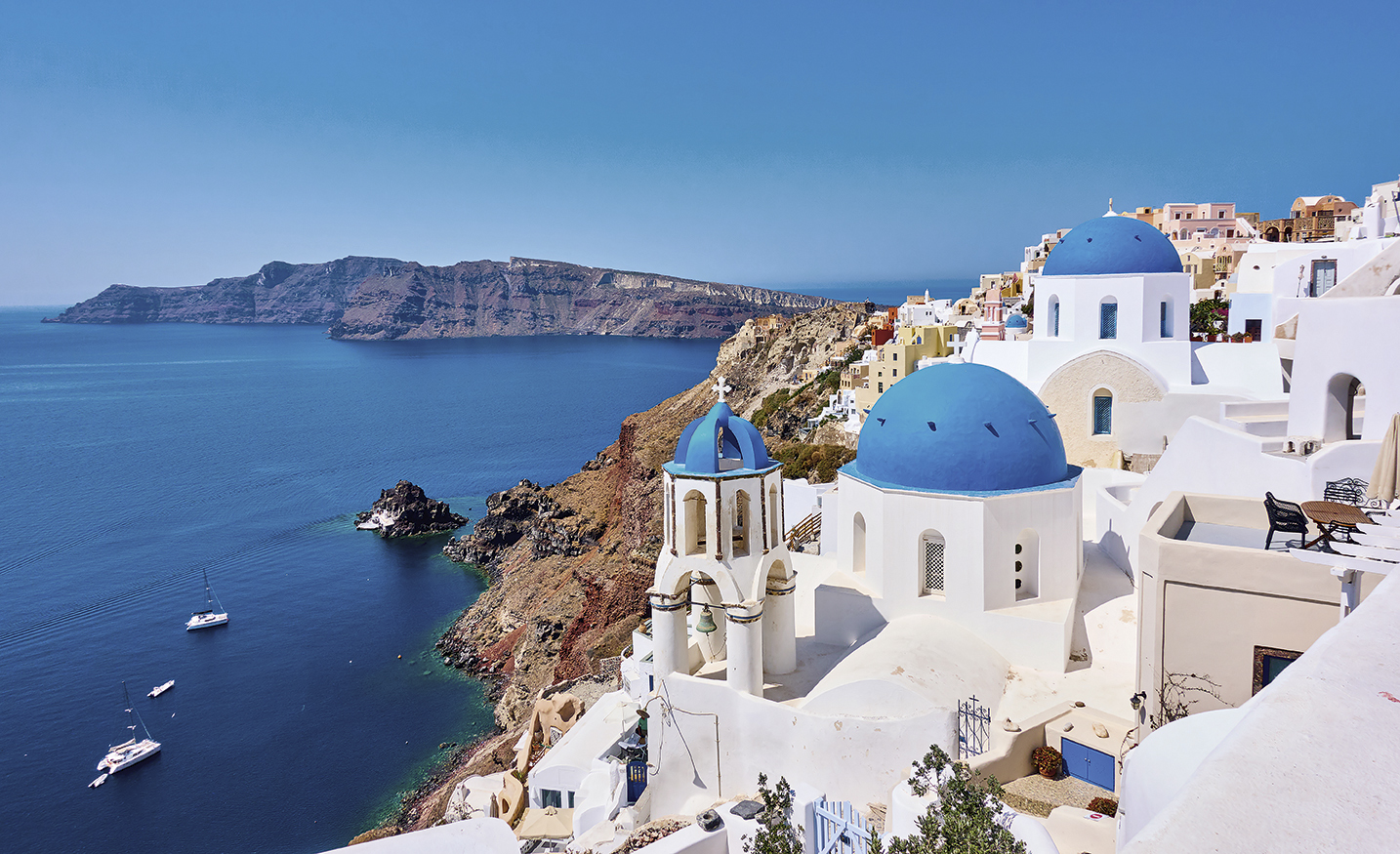
Photo by Shutterstock
Famous for its hospitality, Cretans delight in introducing guests to the island's fermented breads, fine olives, fragrant thyme honey and much more besides
Cretans, alone among Mediterranean people, have always made bread, the perfect complement to their exquisite and internationally acclaimed olive oil – the centrepiece to every table. Their traditional bread is made from barley, a cereal that gave its Cretan name, dea, to Demeter, the Greek goddess of grain and agriculture. For it's a nutritionally valuable grain, especially when made into bread the Cretan way – stone-ground and fermented naturally. This is only one bread among many – twice-baked, paximathia, festive, tsoureki, olive, eliopsomo – that you'll find in the busy Heraklion bakery of expert bakers Christoforos Veneris and his son Nikos.
Crete is the fifth-largest island in the Mediterranean
and is endowed with a far greater biodiversity of
flora and fauna than any other European island.
Together with its fine olive oils, slow-fermented
breads, rich yoghurt, wines, abundant seafoods, fruits
(figs, quince, apricots, pears), free-ranging animals,
and a love of music and hospitality, xenia, Cretans
have given us the Cretan diet. And the best way to
experience this way of life is to take a road trip.
Leaving Heraklion, the capital, head south, passing Knossos, the archaeological site of a Minoan palace, and low hills latticed with the terraces the Minoans built – and are still used – for barley, olive trees and vines. In the acclaimed Lyrarakis Winery, taste old native grape varietals – vilana, dafni, thrapsathiri, plyto, liastos, liatiko – made into modern wines in this beautiful and atmospheric valley. A few kilometres further, in Houdetsi's tree-shaded Semeli taverna, try mezes of taramosalata (made with salted cod's roe), wild greens salad, xortosalata, grilled kefalotyri cheese, and slow-cooked local beef, a rare delight on this pasture-sparse island.
Travelling further south, you have wonderful views of hillsides covered in olive groves, herb-feasting goats, distant villages and small churches, before you reach the impressively large Messara Plain. The occupying Romans (67BC-330AD) considered this their empire's bread basket, while the earlier Minoans built a thriving trade with Egypt from its produce.
In nearby Domaine Zacharioudakis, try more native varietals – malvazia di candia, vidiano, kotsifali – while enjoying the spectacular view westwards to the Libyan Sea. Stop at Gortyn (the Roman capital) and Phaestos, a beautiful Minoan site, both on the plain, before heading a few kilometres south-west to the coast. At Delfinia fish taverna in Kalamari, ask to see the catch of the day – maybe John Dory, christopsaro, red mullet, barbounia, dentex, synagrida – and, while you are waiting for your fish to be grilled, baked or sautéed – Cretans have preferred ways of cooking every fish – enjoy mezes of mussels, mythia, clams, akivathdes, oysters, strithia, octopus, squid, kalamari, and sea urchins, achinosalata.
North-west, across the foothills of the Psiloritis mountains, the rugged landscape is the source of deep-amber thyme honey and a world-class cheese, Cretan graviera. Made with unpasteurised sheep's milk, it's rich and creamy at one week old, buttery and semi-hard at three months and gloriously nutty at six months. The road takes you through pretty villages and wonderful scenery, the air perfumed with wild herbs – thyme, thymari, mint, thiosmos, oregano, rigani, and sage, faskomilia. Some of these are in your tea (faskomilia, especially) when you stop in the ancient mountain village of Thronos, or nearby. Stop, too, in Armeni, for country cooking in Alekos taverna; perhaps hare or rabbit stifado, a slow-braise with small onions and spices, or tender lamb with artichokes, arni aginara.
You'll find exquisite, delicate, honey-sweet
pastries in bakeries in Rethymno, a dramatic
Venetian-era fortress town on the north coast, and
delectably creamy, sheep's milk yoghurt 30km
further west, in Vrisses. Round off your road trip in
the atmospheric town of Chania just as you started
it, by experiencing the Cretan diet, a way of life – food, wine, xenia, friends – that the islanders have
been enjoying for centuries.
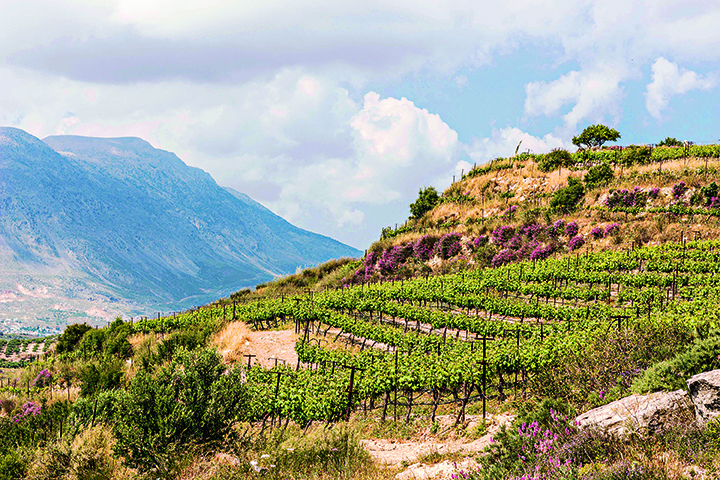
Photo by Gary Latham
Gentle breezes carry the scent of thyme across this Aegean island, whose wild beauty and culinary heritage both beg to be explored, whether with a picnic-perfect cheese pie or a taverna feast
Nearly a century ago, difficult times meant most of Kythira's population departed, leaving its herb-shrouded moorland, deep ravines, and 300 monasteries and churches to the bees, goats and artisanal knowledge of its remaining families. Today, this 278sq km island of and wild beauty is home to some very fine foods. Even its salt is pure; it's collected by hand from salt 'ponds', where sea water remains in rock pools and slowly evaporates into the crystals that are then harvested ready for use.
Rock samphire, kritamo, and capers, capari, thrive on rocky sea cliffs and flavour many island seafood dishes, especially those featuring cuttlefish. Inland, other wild greens flourish on the goat-fertilised soil: fresh, slightly bitter chicory, purslane, glystritha, packed with omega-3 fatty acids and especially delicious in salads, 'water-jug thorn', stamnagathi, spinach, aghriospanakia, and beets, vlita, used for filling pies.
Squatting between the Ionian and Aegean Seas, Kythira's weather can be temperamental, and island cooks are skilled at making comforting pies and oven bakes. These are also on the menu in tavernas; try mezes of xortopites and local olives in the dramatic, clifftop terrace of Michalis, in Mitata, and bakes of seasonal game, chicken with cinnamon, koutopoulo kanella, and grilled lamb rib chops, paidokakia.
Head to Potamos, the island's largest town, for its Sunday produce market – honeys, cheeses, herbs, yoghurt, local vegetables – and a browse in the bakery for twice-baked wholewheat bread, flavoured with carob or mastic, an aromatic berry native to the Eastern Mediterranean; at the 'sugar shop', zacharoplastio, for almond cookies, kourambiedes, fig, cherry, orange and grape preserves and other sweetmeats; and the wine shop, oinopoleio. Pause for mezes – fried anchovies, gavros, mashed aubergine, melitzanosalata – with the local firewater, tsipouro, and live music in the café, before going a few kilometres south to Milopotamos, a delightful village in a wooded valley, for Greek coffee under the huge plane tree that dominates the main square.
Take the footpath west to Kato Chora ('below town'), an eerie, abandoned, Venetian-built settlement of intersecting lanes and small Byzantine churches, to catch a spectacular sunset. An even more incredible ghost town is found in a deep ravine just west of Potamos. Paleochora is the ruined medieval capital of Kythira, hidden from view from the sea. This didn't stop the pirate Barbarossa from sacking it, however, and killing or enslaving all the inhabitants. No one has lived here since, but a guide will help you explore this unforgettable, isolated place of 70 churches.
The thyme- and sage-covered moors above the ravine are host to bees who produce some of the best honey in the world. Taste it in the Mitata smallholding of Ioannis and Eleni Proposaltis, with fresh cheese they make from their herb-rich goat's milk. In Filio, in Kalamos, Nikos and Katerina Kalligeros also make fresh cheese, which they turn into delectable savoury and sweet pies, and a special island pancake. Take a seat on their mulberry tree-shaded terrace to try rooster in wine and homemade pasta, hilopites, and oil bread, tiganopsomo ('oil' here means first-pressing olive oil from the family farm). The oil is made from a wheat varietal they have reintroduced to Kythira.
Centuries-old goat tracks criss-cross the island. One, from Agia Sophia, near Kavalos, takes you through glorious scenery to the spectacular view of Kapsali, a small, double-bayed harbour on the dazzlingly blue Aegean that lies several hundred metres below. Two steep kilometres further west, a formidable castle rises above the small houses tumbling down the wildflower-dotted hillsides of Chora, the capital of Kythira. Stop on the secluded terrace of Zorbas for grills of local meats, before walking up to the castle for a superb view of the islet Avgo ('egg'), an apt name for the birthplace of the beautiful goddess Aphrodite.
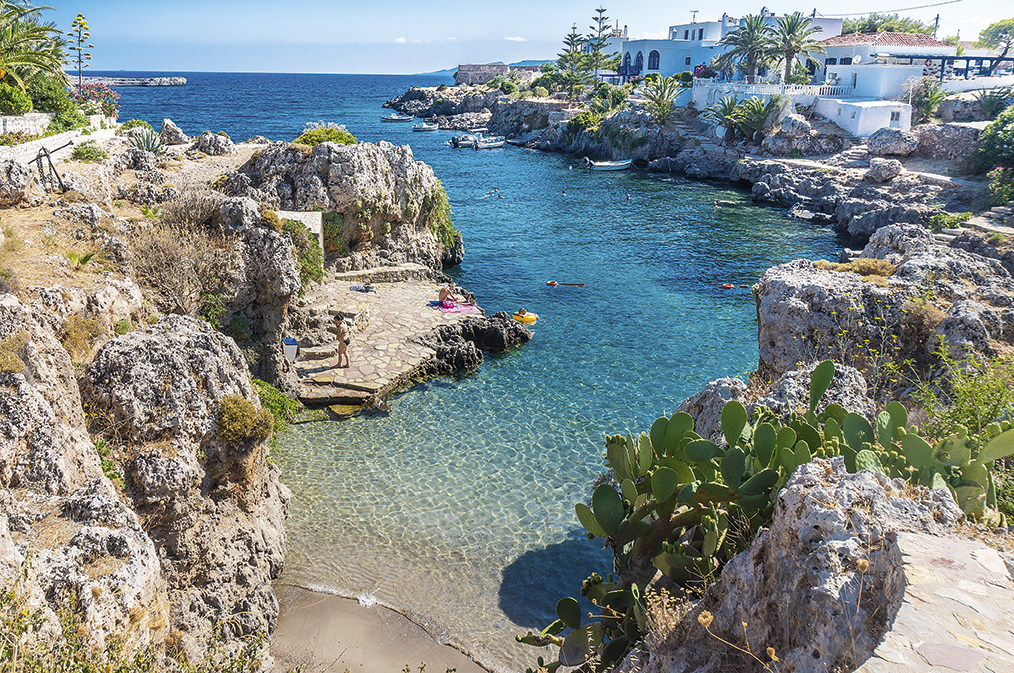
Photo by Shutterstock
This windswept isle is blessed with exceptional fresh produce and countless dishes that do it justice, from artichokes 'in the style of the city' to a hearty chickpea stew cooked in a clay pot
The neat, undulating landscape of Paros hides secrets; one, is its traditional rhythm of life that's still followed to this day. An unhurried 90-minute walk along an imposing, Byzantine-era flagstone path from Prodromos, 10km east of Parikia, the island's port and main town, to Lefkes, the old Ottoman capital, takes you past a beguiling, centuries-old landscape. Before you leave Prodromos, a warren of twisting lanes of small houses, worn steps and bougainvillea- covered archways, stop at one of its many attractive coffee shops for a glass of island ouzo, souma, or local wine, krasi, to set you on your way, and at the bakery for pies stuffed with fresh cheese or wild greens to take with you. As the path rises, so does the perfume of the wild herbs, scenting the air as you pass olive groves, small vineyards and well-tended vegetable gardens of beans and other vegetables that require little water. For Paros is windswept, its soil dry.
The path continues past small pine forests to the marbled alleyways of Lefkes, on to a popular town square. Refresh here in a café serving small dishes, mezepoleion, that suit being served alongside souma or wine: island specialities of chickpea stew cooked in a clay pot, revithada, snails, lightly fried or in tomato sauce, small, stuffed vine leaves, dolmadakia, fresh black-eyed peas, mavromatika, and fried 'balls' made from courgettes, tomatoes, chickpeas or meat.
Paros's prosperity was founded on white marble, quarried from the Cycladic Age (3200-1050 BC), through Roman, Venetian and Ottoman times. A stroll around Upper Town (or 'Kastro') takes you past Venetian fortifications recycled from a classical past, along streets lined with pretty houses covered in cascading jasmine. Pause on the meandering Old Market Street for a few mezes – olives, slices of local beef sausage, fried, small cheese-pastries with honey, rafiolia – before heading down to the waterfront to watch the setting sun from a taverna terrace. In Koralli, try grilled sun-dried salted mackerel, gouna, or fish soup, kakavia; in Albatros, opt for the cuttlefish, wild greens and spicy cheese dip, tyrokafteri.
Paros has plenty of – often windy – beaches, some reached only by small boat (easily arranged in the nearest village), and many good tavernas. Its fishing fleet brings in a seasonal catch of tuna, bonito, bream, red mullet, octopus, cuttlefish, bogue and rockfish; try one of the meze cafés serving fish in Alyki. Eastwards along the coast, in Drios, let the flavours in atmospheric Estiatorio Anna take you back to a vibrant past: artichokes 'in the style of the city', aginares à la polita ('the city' being the Byzantine capital Constantinople, now Istanbul), mashed dried beans with octopus, and goat with lemon juice, katsiki lemonato, along with their own barrel wine.
For millennia, islanders grew vines spread low across the soil, thus protected from strong winds and sun, and medieval Venetian merchants became wealthy exporting Paros wines – ruby-red and sweet – to Northern Europe. Winemakers these days grow grapes – red varietals, monemvasia, mandilaria; whites, savatiano, aidani – upright, with plenty of support, and distill souma from the pulp of the pressed grapes in huge cauldrons, rakidia, in the autumn.
Paros's wealth was no secret to the pirates who
once prospered in Cycladic waters, the reason the
old Ottoman capital is inland, and tiny Antiparos, just off the coast, has a small medieval settlement
accessible only through a diminutive archway off the town's eucalyptus-shaded square. But the
island's best-kept secret, the sheer pleasure of its
cuisine's complementary flavours, still thrives. This is a place where strong cheeses – stored in olive oil,
lathotiri, drained in pots, kopanisti, aged in goat skin,
tourmoumi – and the earthy flavours of foraged foods,
plus the pick of kitchen gardens, are a pleasure to
linger over, along with the powerful Paros wines.
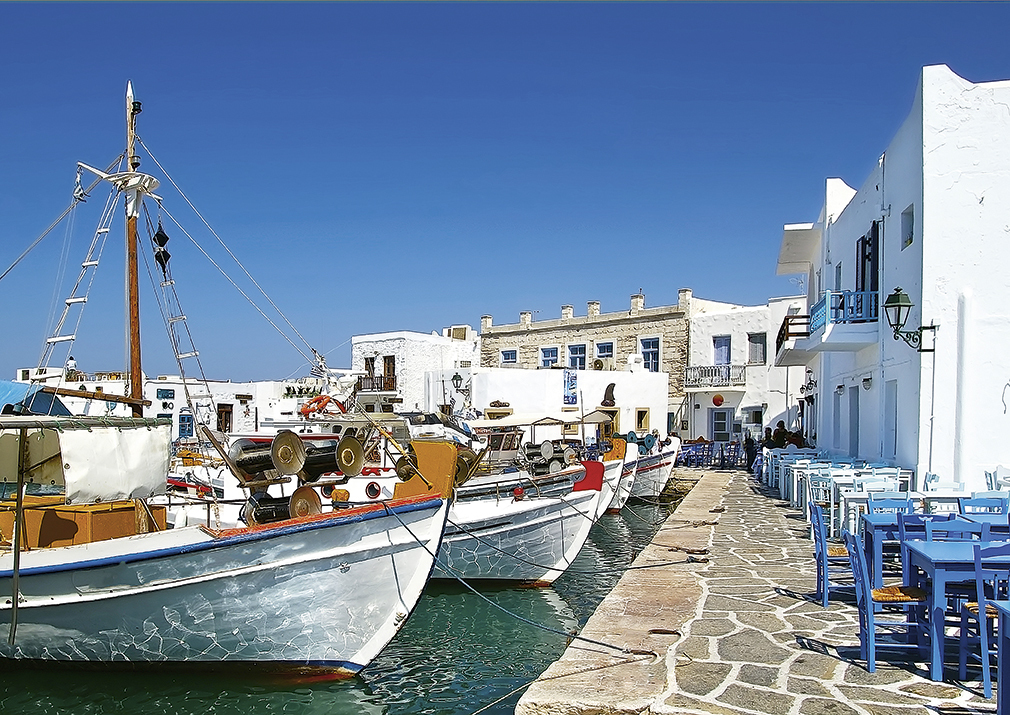
Photo by Shutterstock
Subscribe and view full print editions online... Subscribe